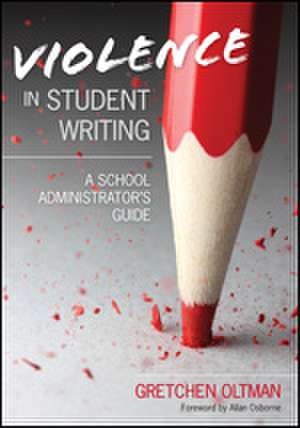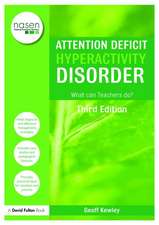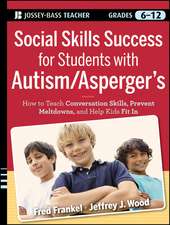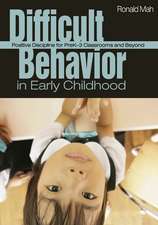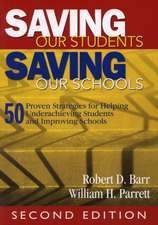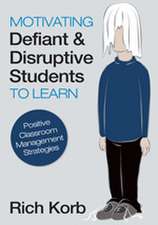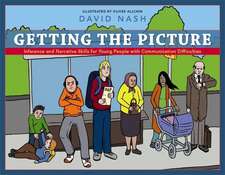Violence in Student Writing: A School Administrator's Guide
Autor Gretchen A. Oltmanen Limba Engleză Paperback – 11 dec 2012
Preț: 232.32 lei
Nou
Puncte Express: 348
Preț estimativ în valută:
44.46€ • 48.28$ • 37.35£
44.46€ • 48.28$ • 37.35£
Carte tipărită la comandă
Livrare economică 23 aprilie-07 mai
Preluare comenzi: 021 569.72.76
Specificații
ISBN-13: 9781452203973
ISBN-10: 1452203970
Pagini: 144
Dimensiuni: 178 x 254 x 15 mm
Greutate: 0.32 kg
Ediția:1
Editura: SAGE Publications
Colecția Corwin
Locul publicării:Thousand Oaks, United States
ISBN-10: 1452203970
Pagini: 144
Dimensiuni: 178 x 254 x 15 mm
Greutate: 0.32 kg
Ediția:1
Editura: SAGE Publications
Colecția Corwin
Locul publicării:Thousand Oaks, United States
Recenzii
"Today's school administrators strive to balance student safety without compromising student creativity and supportive educational climates. Violence in Student Writing: A School Administrator’s Guide provides educators with legal and education frameworks for distinguishing students who are writing about violence from writing by violent students. Knowing the difference between the two can possibly save lives."
“What is so special about this book (and the author!) is the comprehensive nature of the issue, the historical and legal perspectives, and the sensible recommendations the author provides to handle what can be a tenuous situation. The author presents the reader with the social, educational and legal aspects of the issue while at the same time providing strategies and procedures that the administrator can feel comfortable about developing and implementing that encourage the creativity in students as well as ensure the safety and trust in attending school.”
“This book provides an in depth look at the educators and school administrators responsibility to respond to student work samples that are threatening, abusive, and violent. The aim of the book is to provide an awareness of what is student violent writing, how the English teacher can promote creative writing with guides, and applications for immediate response using a systematic approach once a report has been made involving a violent student writing.
I highly recommend this book for all educators, parents, and professional scholars interested in Education in the 21 Century.”
“Timely and relevant in today’s educational climate. This book will encourage educators and administrators to remain aware, cautious, and empowered.”
“This exceptionally practical book addresses the pervasive issues that school staff members face today.”
"Gretchen Oltman offers an important book on a subject that helps us understand the challenges of the past, those of the present, and (gulp!) those we cannot yet imagine. Increased emphasis on writing, combined with evolving trends in online media and bullying, make this a book we all need to keep handy. Here, Gretchen combines her wisdom as both a classroom teacher and a lawyer, offering us a guide we can trust as we all seek to navigate our way through the complex landscape of writing instruction."
"Rarely do authors have the ability to bring the law alive by providing teachers and administrators with deep understanding of its practical application in their schools. This book is an insightful look into the power of school culture, instructional decision making, policy development, and student well-being through the lens of violent writing, both on and off campus. The writing is compelling, the scholarship is deft, and Oltman’s clear focus on the real work of schools makes this book a must read."
"I know first hand how destructive high schools can be in handling student writing that makes them uncomfortable. In some cases students with no record of violence have been suspended, and their reputations permanently altered, just because their English teacher was frightened by something they wrote. Oltman's book presents the case for much more intelligent policies. Teams of educators who have researched the issue and have spoken to the students should be making these decisions, she says. This is a sensible guide that should be required reading for all principals."
“What is so special about this book (and the author!) is the comprehensive nature of the issue, the historical and legal perspectives, and the sensible recommendations the author provides to handle what can be a tenuous situation. The author presents the reader with the social, educational and legal aspects of the issue while at the same time providing strategies and procedures that the administrator can feel comfortable about developing and implementing that encourage the creativity in students as well as ensure the safety and trust in attending school.”
“This book provides an in depth look at the educators and school administrators responsibility to respond to student work samples that are threatening, abusive, and violent. The aim of the book is to provide an awareness of what is student violent writing, how the English teacher can promote creative writing with guides, and applications for immediate response using a systematic approach once a report has been made involving a violent student writing.
I highly recommend this book for all educators, parents, and professional scholars interested in Education in the 21 Century.”
“Timely and relevant in today’s educational climate. This book will encourage educators and administrators to remain aware, cautious, and empowered.”
“This exceptionally practical book addresses the pervasive issues that school staff members face today.”
"Gretchen Oltman offers an important book on a subject that helps us understand the challenges of the past, those of the present, and (gulp!) those we cannot yet imagine. Increased emphasis on writing, combined with evolving trends in online media and bullying, make this a book we all need to keep handy. Here, Gretchen combines her wisdom as both a classroom teacher and a lawyer, offering us a guide we can trust as we all seek to navigate our way through the complex landscape of writing instruction."
"Rarely do authors have the ability to bring the law alive by providing teachers and administrators with deep understanding of its practical application in their schools. This book is an insightful look into the power of school culture, instructional decision making, policy development, and student well-being through the lens of violent writing, both on and off campus. The writing is compelling, the scholarship is deft, and Oltman’s clear focus on the real work of schools makes this book a must read."
"I know first hand how destructive high schools can be in handling student writing that makes them uncomfortable. In some cases students with no record of violence have been suspended, and their reputations permanently altered, just because their English teacher was frightened by something they wrote. Oltman's book presents the case for much more intelligent policies. Teams of educators who have researched the issue and have spoken to the students should be making these decisions, she says. This is a sensible guide that should be required reading for all principals."
Cuprins
Foreword by Allan Osborne
Preface
Acknowledgments
About the Author
Introduction
1. The Aftermath of Columbine on Student Writing
A Brief History of School Violence
The Columbine and Jonesboro Shootings: Writings as a Pretext for Violence
The Columbine Effect
The Aftermath of Columbine on the Student Writer
Boston, Massachusetts
Cary, Illinois
West Warwick, Rhode Island
Prosser, Washington
Johnston, Rhode Island
Summary
Practical Applications for Teachers and Administrators
For K-6 Schools
For 7-12 Schools
Questions to Consider
2. Schooling for Citizenship: A Legal Primer for Educators
Freedom of Expression in Today's Public Schools
The U.S. Constitution
Tinker v. Des Moines Independent School District
Bethel v. Fraser
Hazelwood v. Kuhlmeier
Morse v. Frederick
How Do These Cases Apply to Classroom Writing Samples?
The True Threat Standard
The Court’s Call for Citizenship Education
Citizenship Education Through the Curriculum
Courts Agree – Public Schools Are More Than Books and Pencils
Summary
Practical Applications for Teachers and Administrators
For K-6 Schools
For 7-12 Schools
Questions to Consider
3. School Culture and Student Safety
What Students Write About (And What It Can Say About Your School Culture)
The School Administrator’s Influence On School Culture
Improving Your School Culture
Summary
Practical Applications for Teachers and Administrators
For K-6 Schools
For 7-12 Schools
Questions to Consider
4. Regulating Student Expression: Examining Your School Policy
Why a Zero Tolerance Approach Fails Everyone
Incorporating Legal Principles Into School Policies
Sample Policies
Summary
Practical Applications for Teachers and Administrators
For K-6 Schools
For 7-12 Schools
Questions to Consider
5. Violent Writing Within the Classroom
Freewriting Is Not the Cause of School Violence
Writing as a Predictor of Violence
Writing Instead of Violence
The Unique Nature of the Writing Classroom
“But, Teacher, I Want To Be the Next Stephen King...”
The Lost Lesson: Purpose and Audience
Advice for All Teachers of Writing
Summary
Practical Applications for Teachers and Administrators
For K-6 Schools
For 7-12 Schools
Questions to Consider
6. Violent Writing Beyond the Classroom
Off-Campus Writings
Cases Where Schools Prevailed
Cases Where Students Prevailed
Cyberbullying, Texting, and Facebook Writings
When the Violent Writing Targets You
Staying Informed
Summary
Practical Applications for Teachers and Administrators
For K-6 Schools
For 7-12 Schools
Questions to Consider
7. Communicating With Teachers About Student Violent Writing
Conversing With Teachers Before the School Year Begins
Recognizing Potential Syllabus Problems
Reviewing Teacher Classroom Policies
Suggesting Teaching Methods When You Are Not a Writing Teacher
Continuing the Conversation
Summary
Practical Applications for Teachers and Administrators
For K-6 Schools
For 7-12 Schools
Questions to Consider
8. Threat Assessment for Student Violent Writing Incidents
Assessment Does Not Mean Profiling
Listening and Threat Assessment
Keep a Copy of Student Writing
A Sample Threat Assessment Form for Student Violent Writing Incidents
Summary
Practical Applications for Teachers and Administrators
For K-6 Schools
For 7-12 Schools
Questions to Consider
9. Acting and Responding to Student Violent Writing
The Need for a Timely Response
Responding Reasonably to All Student Violent Writing
Creating a Documentation Trail
Potential Administrative Responses
Summary
Practical Applications for Teachers and Administrators
For K-6 Schools
For 7-12 Schools
Questions to Consider
References
Appendix A
Preface
Acknowledgments
About the Author
Introduction
1. The Aftermath of Columbine on Student Writing
A Brief History of School Violence
The Columbine and Jonesboro Shootings: Writings as a Pretext for Violence
The Columbine Effect
The Aftermath of Columbine on the Student Writer
Boston, Massachusetts
Cary, Illinois
West Warwick, Rhode Island
Prosser, Washington
Johnston, Rhode Island
Summary
Practical Applications for Teachers and Administrators
For K-6 Schools
For 7-12 Schools
Questions to Consider
2. Schooling for Citizenship: A Legal Primer for Educators
Freedom of Expression in Today's Public Schools
The U.S. Constitution
Tinker v. Des Moines Independent School District
Bethel v. Fraser
Hazelwood v. Kuhlmeier
Morse v. Frederick
How Do These Cases Apply to Classroom Writing Samples?
The True Threat Standard
The Court’s Call for Citizenship Education
Citizenship Education Through the Curriculum
Courts Agree – Public Schools Are More Than Books and Pencils
Summary
Practical Applications for Teachers and Administrators
For K-6 Schools
For 7-12 Schools
Questions to Consider
3. School Culture and Student Safety
What Students Write About (And What It Can Say About Your School Culture)
The School Administrator’s Influence On School Culture
Improving Your School Culture
Summary
Practical Applications for Teachers and Administrators
For K-6 Schools
For 7-12 Schools
Questions to Consider
4. Regulating Student Expression: Examining Your School Policy
Why a Zero Tolerance Approach Fails Everyone
Incorporating Legal Principles Into School Policies
Sample Policies
Summary
Practical Applications for Teachers and Administrators
For K-6 Schools
For 7-12 Schools
Questions to Consider
5. Violent Writing Within the Classroom
Freewriting Is Not the Cause of School Violence
Writing as a Predictor of Violence
Writing Instead of Violence
The Unique Nature of the Writing Classroom
“But, Teacher, I Want To Be the Next Stephen King...”
The Lost Lesson: Purpose and Audience
Advice for All Teachers of Writing
Summary
Practical Applications for Teachers and Administrators
For K-6 Schools
For 7-12 Schools
Questions to Consider
6. Violent Writing Beyond the Classroom
Off-Campus Writings
Cases Where Schools Prevailed
Cases Where Students Prevailed
Cyberbullying, Texting, and Facebook Writings
When the Violent Writing Targets You
Staying Informed
Summary
Practical Applications for Teachers and Administrators
For K-6 Schools
For 7-12 Schools
Questions to Consider
7. Communicating With Teachers About Student Violent Writing
Conversing With Teachers Before the School Year Begins
Recognizing Potential Syllabus Problems
Reviewing Teacher Classroom Policies
Suggesting Teaching Methods When You Are Not a Writing Teacher
Continuing the Conversation
Summary
Practical Applications for Teachers and Administrators
For K-6 Schools
For 7-12 Schools
Questions to Consider
8. Threat Assessment for Student Violent Writing Incidents
Assessment Does Not Mean Profiling
Listening and Threat Assessment
Keep a Copy of Student Writing
A Sample Threat Assessment Form for Student Violent Writing Incidents
Summary
Practical Applications for Teachers and Administrators
For K-6 Schools
For 7-12 Schools
Questions to Consider
9. Acting and Responding to Student Violent Writing
The Need for a Timely Response
Responding Reasonably to All Student Violent Writing
Creating a Documentation Trail
Potential Administrative Responses
Summary
Practical Applications for Teachers and Administrators
For K-6 Schools
For 7-12 Schools
Questions to Consider
References
Appendix A
Notă biografică
Descriere
Your guide to action when student writing crosses the line
At what point should violent student expressions be considered a legitimate threat? This legal handbook delves into the real-life experiences of administrators, teachers, and students to help you apply caution and logic in protecting your students' freedom of speech while also protecting the safety of everyone in the building. Gretchen Oltman, an experienced educator and licensed attorney, shows you how to:
At what point should violent student expressions be considered a legitimate threat? This legal handbook delves into the real-life experiences of administrators, teachers, and students to help you apply caution and logic in protecting your students' freedom of speech while also protecting the safety of everyone in the building. Gretchen Oltman, an experienced educator and licensed attorney, shows you how to:
- Prevent violence by creating a positive and safe school environment
- Guide teachers in assessing written threats of violence
- Evaluate writing outside the classroom, including texting and Facebook postings
